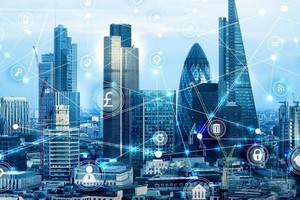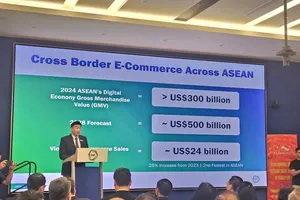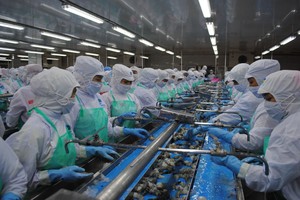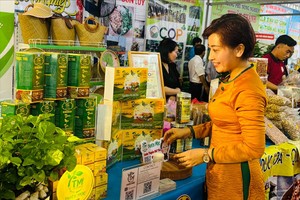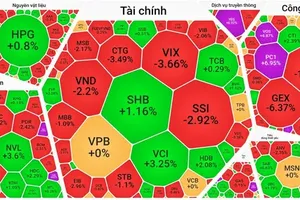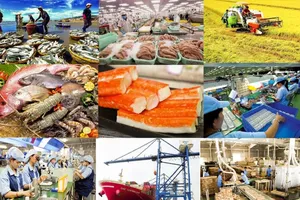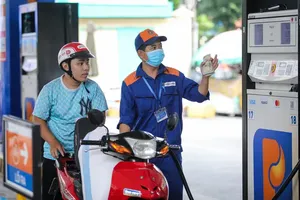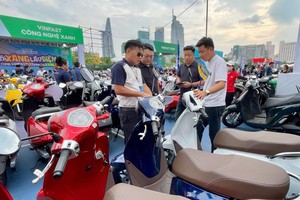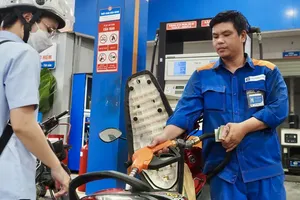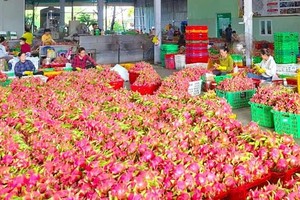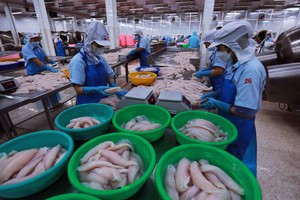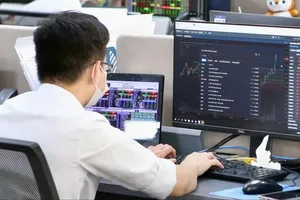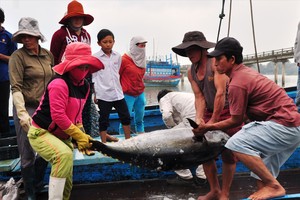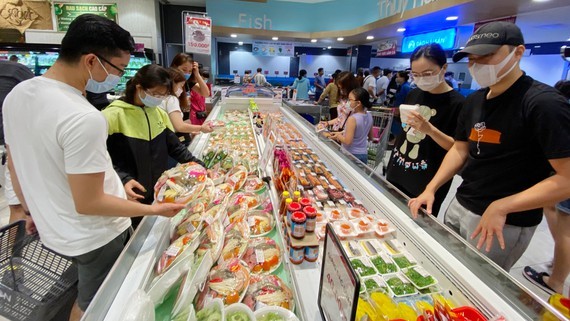 People go shopping at a supermarket in HCMC. (Photo: SGGP)
People go shopping at a supermarket in HCMC. (Photo: SGGP)
Enterprises are the driving force of growth
After the country reunified, HCMC has been growing ceaselessly and always maintained high economic growth. From 2011 to 2019, despite the impact of the global economic crisis, the city also achieved economic growth of approximately 10 percent per year, 1.66 times higher than the average growth of the country of 5.8 percent.
However, the economic development strategy of HCMC is being affected by profound fluctuations and is facing many uncertainties. In 2020, for the first time in decades, the gross regional domestic product (GRDP) growth rate was lower than the national growth rate (less than half of that of the whole country). Due to the implementation of many support policies to reschedule and reduce taxes, the growth rate of State budget revenue decreased for the first time by 14.2 percent. The HCMC government had to cut nearly 10 percent of local budget spending, while the need for capital to invest in infrastructure to stimulate growth is extremely huge. The trend of moving large enterprises out of Ho Chi Minh City has been increasingly visible due to the rise and competition to attract investment from neighboring provinces, such as Long An, Binh Duong, and Dong Nai. With great openness and the international economic integration process, the economy of HCMC is affected in many ways.
Mr. Nguyen Thanh Phong, Member of the Party Central Committee, Chairman of the People's Committee of HCMC, affirmed that the contingent of enterprises and entrepreneurs is the driving force to promote economic growth in 2021. Therefore, HCMC will persist with decisive solutions, in which improving the business investment environment and administrative reform are prioritized. The municipal People's Committee requires departments and industries to strengthen the legal corridor and discipline in public services, innovate the handling process with a breakthrough spirit, continue to cut unnecessary administrative procedures that obstruct people and enterprises. The city will focus on the stage of organizing for implementation, highlight the responsibility of the leader, create a movement throughout the system so that the policies can be put into practice.
Plenty of room for development
Along with administrative reform and the investment environment, by the end of last year, the People's Committee of HCMC has approved and issued several key programs and projects. Especially, HCMC focused on implementing key contents, continuing to innovate economic growth models for rapid and sustainable economic development based on researching and strongly applying science, technology, innovation, and creativeness, and increasing labor productivity.
The project to develop HCMC into a regional and international financial center has been included in the 10-year socio-economic development strategy from 2021 to 2030. At the same time, HCMC will be built into the largest creative startup center in the country, which takes the lead in taking advantage of the opportunities of the fourth industrial revolution, strongly developing digital economy, sharing economy, and circular economy. By making the most of available advantages and adding investment in an innovative and highly interactive urban area in the East - Thu Duc City - which becomes a new pole of growth for HCMC and the region.
Discussing solutions for HCMC to maintain its leading economic position in the country, Dr. Tran Du Lich, a member of the Prime Minister's Economic Advisory Group, said that HCMC must actively recalculate the problem of economic development for the region, instead of only the city, to best bring into play the resources. The city must solve the entanglements of infrastructure, promote the role of seaports and the logistics industry because currently, the risk of congestion is extremely high due to the lack of synchronous development. HCMC needs to capture and diversify resources that are new driving forces to promote a clearly-shaped economy, such as private enterprises, urbanization, financial centers, and services, including healthcare and education. Economic development strategy focuses on key industries because if not selected correctly, it will significantly affect economic growth in the post-Covid-19 period.
After the country reunified, HCMC has been growing ceaselessly and always maintained high economic growth. From 2011 to 2019, despite the impact of the global economic crisis, the city also achieved economic growth of approximately 10 percent per year, 1.66 times higher than the average growth of the country of 5.8 percent.
However, the economic development strategy of HCMC is being affected by profound fluctuations and is facing many uncertainties. In 2020, for the first time in decades, the gross regional domestic product (GRDP) growth rate was lower than the national growth rate (less than half of that of the whole country). Due to the implementation of many support policies to reschedule and reduce taxes, the growth rate of State budget revenue decreased for the first time by 14.2 percent. The HCMC government had to cut nearly 10 percent of local budget spending, while the need for capital to invest in infrastructure to stimulate growth is extremely huge. The trend of moving large enterprises out of Ho Chi Minh City has been increasingly visible due to the rise and competition to attract investment from neighboring provinces, such as Long An, Binh Duong, and Dong Nai. With great openness and the international economic integration process, the economy of HCMC is affected in many ways.
Mr. Nguyen Thanh Phong, Member of the Party Central Committee, Chairman of the People's Committee of HCMC, affirmed that the contingent of enterprises and entrepreneurs is the driving force to promote economic growth in 2021. Therefore, HCMC will persist with decisive solutions, in which improving the business investment environment and administrative reform are prioritized. The municipal People's Committee requires departments and industries to strengthen the legal corridor and discipline in public services, innovate the handling process with a breakthrough spirit, continue to cut unnecessary administrative procedures that obstruct people and enterprises. The city will focus on the stage of organizing for implementation, highlight the responsibility of the leader, create a movement throughout the system so that the policies can be put into practice.
Plenty of room for development
Along with administrative reform and the investment environment, by the end of last year, the People's Committee of HCMC has approved and issued several key programs and projects. Especially, HCMC focused on implementing key contents, continuing to innovate economic growth models for rapid and sustainable economic development based on researching and strongly applying science, technology, innovation, and creativeness, and increasing labor productivity.
The project to develop HCMC into a regional and international financial center has been included in the 10-year socio-economic development strategy from 2021 to 2030. At the same time, HCMC will be built into the largest creative startup center in the country, which takes the lead in taking advantage of the opportunities of the fourth industrial revolution, strongly developing digital economy, sharing economy, and circular economy. By making the most of available advantages and adding investment in an innovative and highly interactive urban area in the East - Thu Duc City - which becomes a new pole of growth for HCMC and the region.
Discussing solutions for HCMC to maintain its leading economic position in the country, Dr. Tran Du Lich, a member of the Prime Minister's Economic Advisory Group, said that HCMC must actively recalculate the problem of economic development for the region, instead of only the city, to best bring into play the resources. The city must solve the entanglements of infrastructure, promote the role of seaports and the logistics industry because currently, the risk of congestion is extremely high due to the lack of synchronous development. HCMC needs to capture and diversify resources that are new driving forces to promote a clearly-shaped economy, such as private enterprises, urbanization, financial centers, and services, including healthcare and education. Economic development strategy focuses on key industries because if not selected correctly, it will significantly affect economic growth in the post-Covid-19 period.
Chairman Nguyen Thanh Phong of the HCMC People's Committee has directed the Department of Planning and Investment to urgently complete the plan to improve the investment environment, supplement and complete the investment stimulus program to meet the requirements of enterprises in the new period, which is expected to be submitted to the People's Council next July. This program encourages the business community, especially young entrepreneurs and start-ups, to participate more actively in planning investment policies with the city, restructuring production and business industries, especially in fields, such as electronics, technology, finance, education, and health.
